[Summary and Discussion]
The usage of ICT devices at schools has significantly changed under the GIGA School Program. However, more data is needed to examine children's attitude toward ICT usage and behavior patterns in using ICT. Therefore, this survey aims to understand the actual conditions of ICT usage and to seek better ways to utilize ICT effectively at schools.
❏ Children's attitude and use of ICT devices: Usage frequency has increased, and about 80% of children answered they "enjoy classes using ICT"
The number of children with more opportunities to use ICT devices in the classroom rapidly increased between 2020 and 2021 (See [Supplemental Data] obtained from the "Parent-Child Survey on Children's Life and Learning"). In particular, as the GIGA concept (one device per child) has been introduced successfully in elementary and junior high schools, about 90% of participant children answered they use "often" or "sometimes" PCs and tablets in the classroom. High schools also introduced the GIGA concept steadily, although the change was not as significant as in elementary/junior high schools. In this survey, we asked children about the frequency of weekly and monthly usage of ICT devices at school. As shown in [Figure 1], about 30% of children said, "5 days a week (almost daily)," and about 20% said, "3-4 days a week."
What do children think about the increased use of ICT devices at schools? [Figure 2-1] shows that about 80% of children "enjoy classes using ICT devices," and about 60% "want more classes using ICT devices." These results indicate that children adapt to the use of ICT devices. In addition, there are no differences in academic performance. This means that children in the upper academic level and those in the lower academic level equally enjoy classes with ICT devices. Meanwhile, [Figure 2-2] shows that children who frequently use ICT devices are more likely to enjoy classes with ICT devices.
❏ Purposes for ICT usage: The majority of children answered "inquiry-based learning," followed by "cooperative learning"
[Figure 3] summarizes how children use ICT devices. About 90% of children answered that they use ICT devices to gain access to learning contents (inquiry-based learning), and more than 60% of children use ICT to "form and convey own thoughts to others," "organize and present the group's ideas," and "share ideas with peers" (cooperative learning). In addition, about 50% of children answered they use ICT for inquiry and reflection, such as to "store ideas and finished tasks" and "reflect on learning contents." This indicates that many children effectively utilize ICT devices that can store what they have learned.
Our analysis also revealed that children's purposes of using ICT vary depending on their educational stages. For example, elementary school students are using ICT devices to "study school subjects," "practice programming," "form and convey own thoughts to others," and "share ideas with peers." On the other hand, high school students are more likely to use ICT devices to "memorize learning material," "take tests," and "communicate with teachers."
❏ Pros and cons of ICT usage: Frequent use of ICT devices helps children have less troubles and concerns
Next, we examined what children think about the positive and negative aspects of using ICT devices in their learning.
[Figure 4] shows that more than 70% of children think ICT makes it "easier to gain access to learning contents," "easier to understand learning contents," "easier to study efficiently," and "more productive when studying as a group." Other abilities of ICT also received positive answers. These results indicate that most children have a positive attitude regarding the use of ICT devices. Children who frequently use ICT devices are more likely to appreciate the benefits of ICT. Therefore, getting used to ICT devices is essential for children to experience the positive outcomes of ICT.
[Figure 5] summarizes the issues of ICT usage. More than 50% of children answered that they have troubles when using ICT devices, such as "eye fatigue," "Internet connection failures," and "worry about damaging ICT devices." Furthermore, 30-40 % of children experienced some disadvantages, such as "fewer opportunities to think deeply to solve problems" and "become easily distracted by anything other than my studying." Therefore, we should carefully observe whether or not children are able to use ICT devices efficiently. These issues arise regardless of the frequency of children's ICT usage. However, issues such as "not knowing how to use certain functions" and "feeling reluctant when typing letters" are due to infrequent usage. These issues can be solved by getting used to ICT devices.
❏ Teachers' assistance is important: Children who often receive teachings are more likely to experience the advantages of ICT; however, such assistance cannot eliminate all of the issues
By analyzing data further, we confirmed that children who often receive teachings, such as "how to use ICT devices," "how to look for and collect information," and "rules and manners for using ICT," are more opted to use ICT, as shown in [Figure 6]. ICT devices are tools and it is crucial to understand how to utilize such tools. Our results indicate that merely using ICT devices is not an effective way of using ICT. Support from teachers and parents is essential to achieve full potential of ICT in education. On the other hand, too much assistance might not always eliminate children's ICT-related troubles and concerns. Therefore, we should also consider other solutions, such as improving environments to facilitate the effective use of ICT devices.
In this project, we will continue to monitor the usage of ICT devices by children, seek better ways for them to utilize ICT, and develop practical instructions and educational materials.
Survey Data: Children's ICT usage at school (from elementary to high school)
- Figures 1 through 6 show data obtained from the "2023 Fact-finding Survey on Children's Utilization of ICT."
- "Supplemental Data" represents 2019-2022 data obtained from the "Parent-Child Survey on Children's Life and Learning."
Results
- Frequency of ICT usage: About 30% of children (4-12th grade) answered they "use ICT five days a week (almost daily)"
- Attitude toward ICT usage: About 80% of children answered they "enjoy classes using ICT devices"
- Purposes of ICT usage: About 90 % of children use ICT devices for "inquiry-based learning," while more than 60% of children use them for cooperative learning, such as to "form and convey own thoughts to others" and "share ideas with peers"
- Strengths of ICT: More than 70 % of children think that ICT makes it "easier to gain access to learning contents," "easier to understand learning contents," and "easier to study efficiently."
- Weaknesses of ICT: Over 50% of children have experienced troubles and concerns, such as "eye fatigue," "Internet connection failures," and "worry about damaging ICT devices"
- Teachers' involvement: Children who often receive teachings when using ICT devices are more likely to recognize the advantages of ICT
- ♦As for the frequency of using ICT devices at schools, about 30% of children answered, "5 days a week (almost daily)," and about 20% answered "3-4 days a week). Overall, 4th through 6th grade utilizes ICT more frequently compared to high school.
- ♦About 80% of children answered they "enjoy classes using ICT devices in the classroom." Furthermore, about 60% answered they want more classes using ICT devices (the sum of "Strongly agree" and "Somewhat agree"). There were no differences in percentage among the groups categorized by academic performance but significant differences existed on the basis of usage frequency.
- ♦Majority of children (87.1%) answered they use ICT devices for "inquiry-based learning," followed by 60% for "cooperative learning," such as to "form and convey own thoughts to others" and "share ideas with peers." Meanwhile, there are variations in children's purposes of using ICT depending on educational stages. Elementary school students are more likely to use ICT to "study school subjects," and high school students are more likely to use ICT to "memorize learning contents."
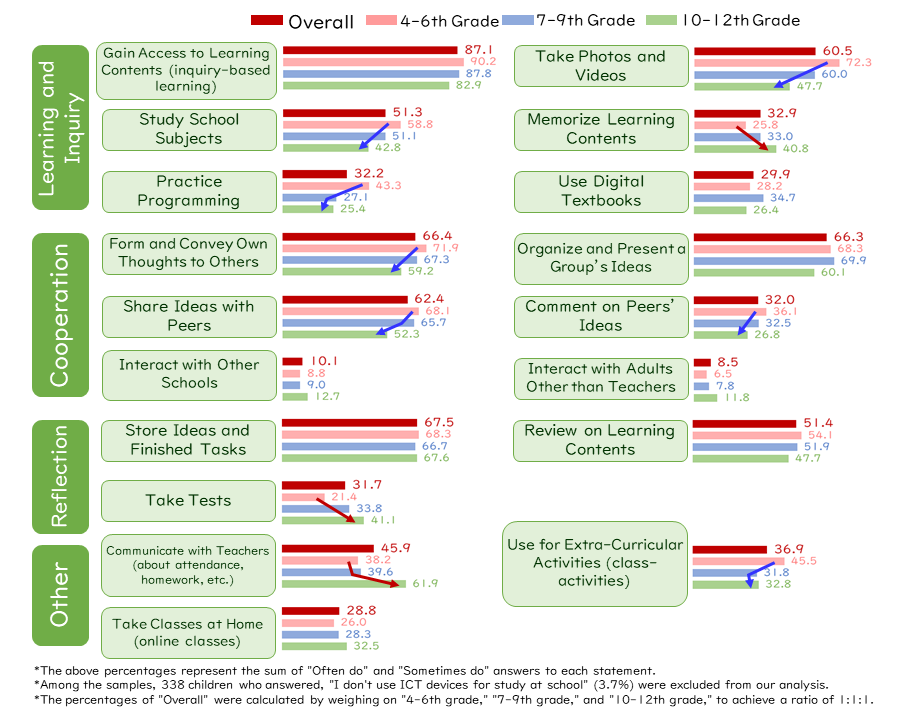
- ♦More than 70% of children have positive thoughts on ICT. For example, they think ICT makes it "easier to gain access to learning contents," "easier to understand learning contents," "easier to study efficiently," and "more productive when studying as a group." In addition, children who frequently use ICT devices are more welcome to use ICT.
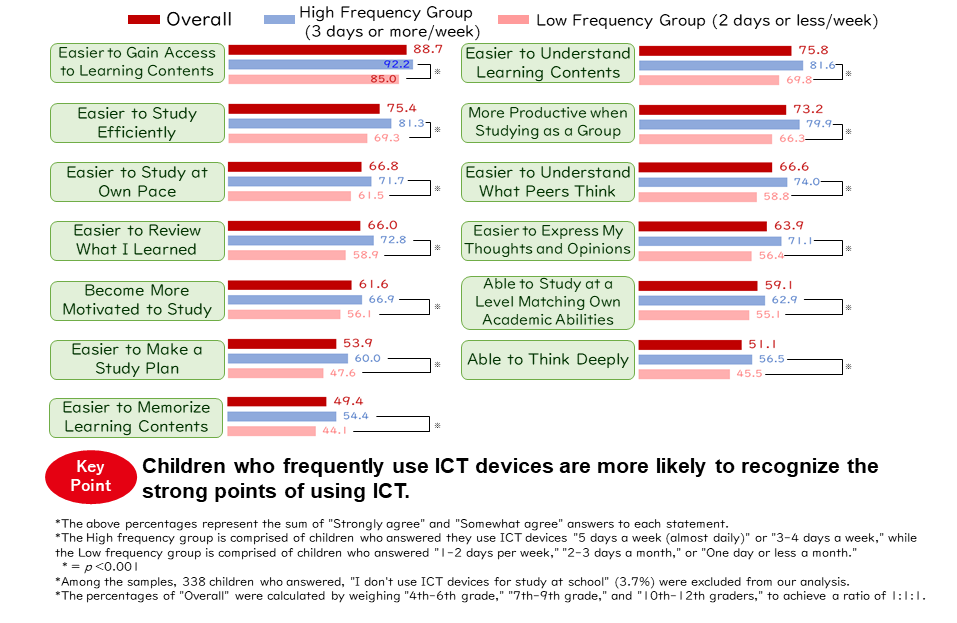
- ♦More than 50% of children answered they have had troubles or concerns in using ICT devices, such as "eye fatigue," "Internet connection failures," and "worry about damaging ICT devices." In addition, children who do not use ICT devices frequently are more likely to have problems such as "not knowing how to use certain functions" and "feeling reluctant when typing letters."
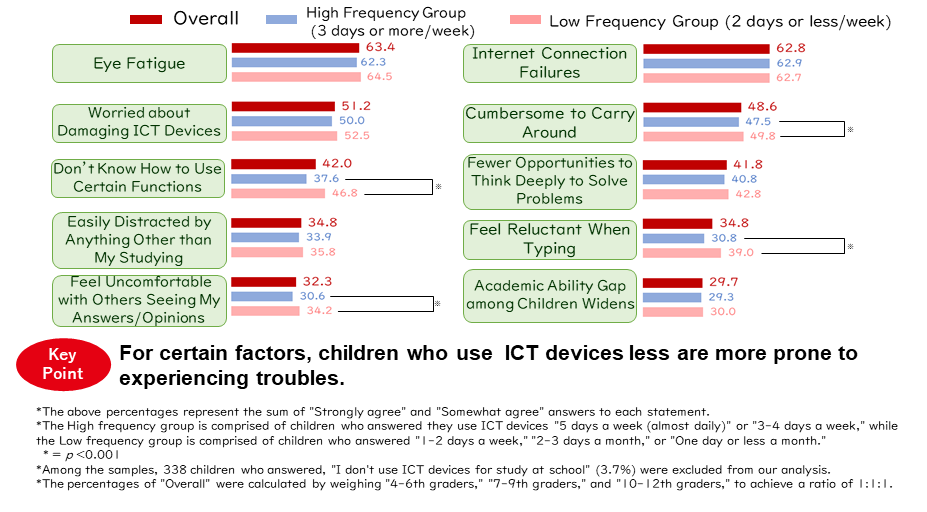
- ♦Children who receive teachings, such as "how to use ICT devices," "how to search and collect information," and "rules and manners for using ICT devices," are more likely to appreciate the merits of ICT.
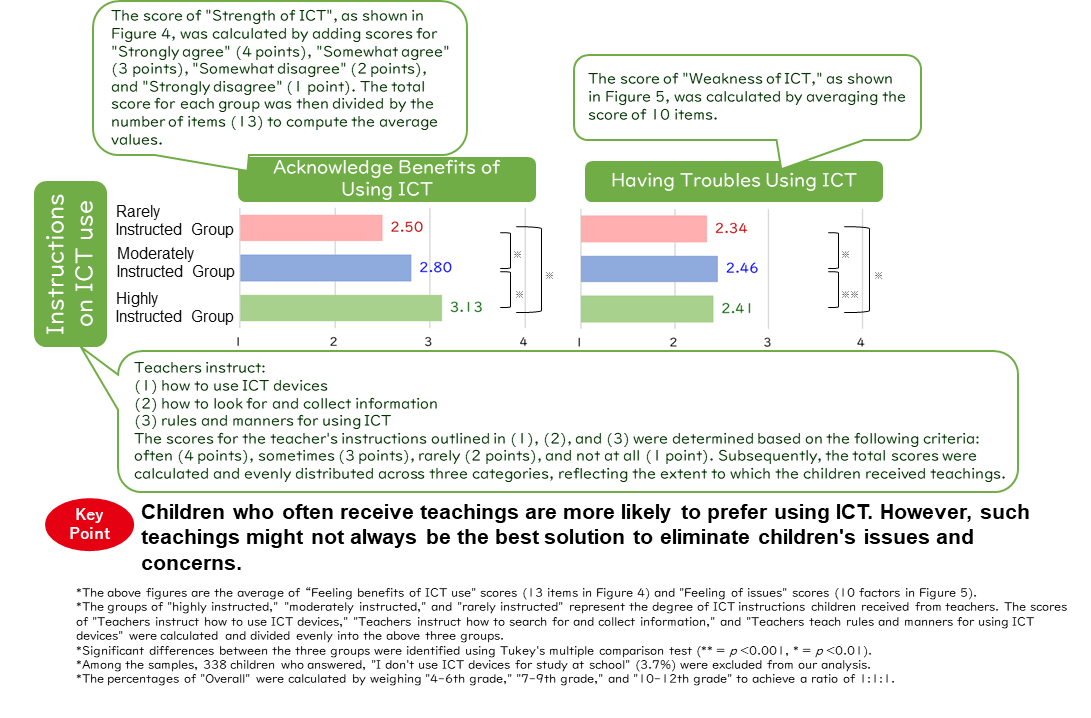
[Supplemental Data] Trend of ICT usage: The number of schools introducing ICT devices in the classroom has rapidly increased between 2020 and 2021
- ♦The usage rate of PCs and tablets in the classroom rapidly increased from 56.9% in 2020 to 81.4% in 2021 and to 86.4% in 2022.
*Data from "Parent-Child Survey on Children's Life and Learning"
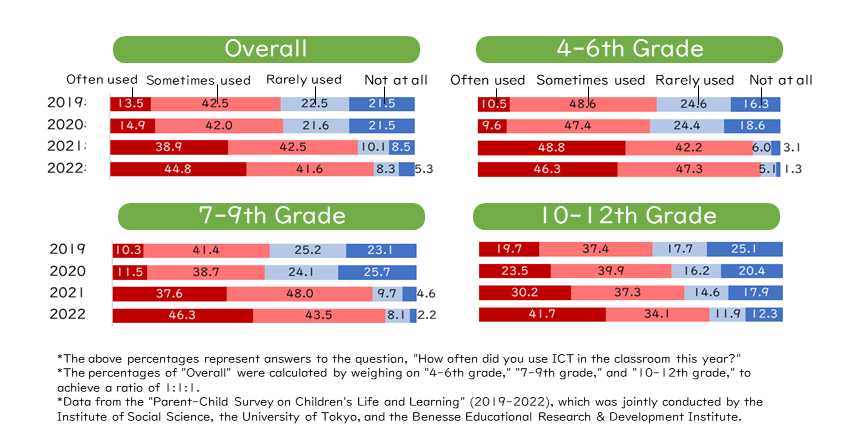
Research Overview
| Title | 2023 Fact-finding Survey on Children's Utilization of ICT *The 2015 Survey (the first survey) is omitted because these results were not included in this analysis. | ||||||||||||||||||||
|---|---|---|---|---|---|---|---|---|---|---|---|---|---|---|---|---|---|---|---|---|---|
| Theme | Children's usage and attitude toward ICT devices at school and home | ||||||||||||||||||||
| Period | From February to March 2023 | ||||||||||||||||||||
| Method | Participations requested by mail; answers were collected online | ||||||||||||||||||||
| Samples | Registered respondents of the "Japanese Longitudinal Study of Children and Parents (JLSCP) " Children in 4-12th grade
| ||||||||||||||||||||
| Members of Children's Life and Learning Research Project | ● Project Leaders Kaori Sato (Professor at the University of Tokyo) and Yuki Nozawa (General Manager of Benesse Educational Research & Development Institute) ● Project Members Hiroaki Mimizuka (Professor emeritus at Ochanomizu University, visiting professor at Aoyama Gakuin University), Kiyomi Akita (Professor at Gakushuin University, Professor emeritus at the University of Tokyo), Kayo Matsushita (Professor at Kyoto University), Hiroshi Ishida (Distinguished professor at the University of Tokyo), Sho Fujihara (Associate professor at the University of Tokyo), Shiroh Ohno (Project associate professor at the University of Tokyo), Hiroko Osaki (Project associate professor at Rikkyo University), Haruo Kimura (Principal researcher at the Benesse Educational Research & Development Institute), Runa Matsumoto (Senior researcher at the Benesse Educational Research & Development Institute), Yumiko Fukumoto (Researcher at the Benesse Educational Research & Development Institute), Masataka Tomonaga (Researcher at the Benesse Educational Research & Development Institute), Koji Nakajima (Senior researcher at the Benesse Educational Research & Development Institute), Satoshi Okabe (Senior researcher at the Benesse Educational Research & Development Institute), Aiping Liu (Senior researcher at the Benesse Educational Research & Development Institute), Hatsue Ouchi (Research staff at the Benesse Educational Research & Development Institute), and Mio Watanabe (Research staff at the Benesse Educational Research & Development Institute) ● Research Working Group Members Kosuke Sudo (Associate professor at Meisei University), Ryosuke Onoda (Associate professor at the Graduate School, University of Yamanashi) *Titles and affiliations are as of November 2023 |
Note: The percentages (%) used in this report have been calculated and then rounded to the first decimal place. Hence, the total percentage may not always sum up to 100.
Additional Information on Survey Data
For more detailed data, please visit the website of the Benesse Educational Research & Development Institute. You can download the "Summary Report" covering the content of this report and survey data (in Japanese).
- About this report (in Japanese): https://berd.benesse.jp/special/childedu/
- Data not included in this report and data summarized by educational stages (in Japanese)
https://berd.benesse.jp/shotouchutou/research/detail1.php?id=5898














